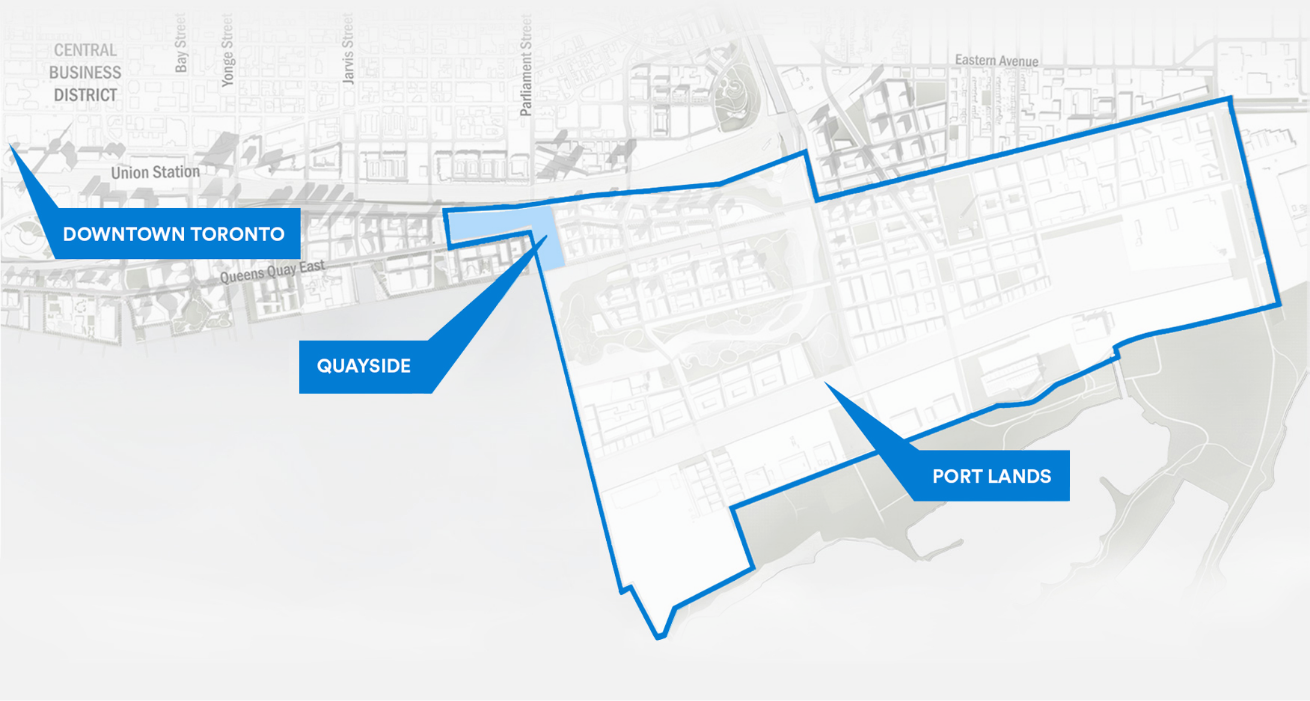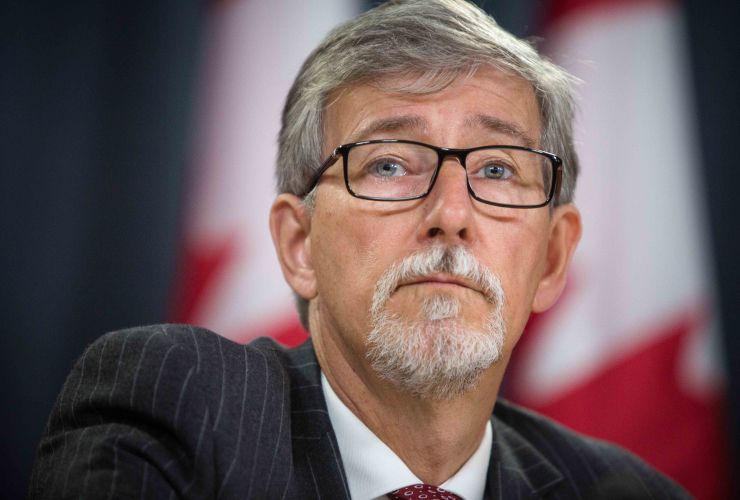A sister company of Google has been secretly considering some ambitious plans for a Toronto neighbourhood on the city's entire eastern waterfront, as the technology giant sets its sights on tax revenues and development fees that would otherwise go into public funds, according to a leaked presentation.
The internal document obtained by National Observer provides stunning insight into the company's "asset manager-like approach" for a proposed smart city neighbourhood — the first of its kind in Canada and considered a blueprint for future urban development worldwide. The company, Sidewalk Labs, is a subsidiary of Google’s parent company Alphabet Inc.
The internal 20-slide presentation — entitled “A Plan at Two Scales” and marked “proprietary and confidential” — raises new questions about the transparency of the company’s planning process and the scope of development it is undertaking over public land and public funds.
The slides, which were presented to around 100 Alphabet employees in November 2018, illustrate Sidewalk Labs’ intentions to develop over 100 acres of Toronto’s Eastern Waterfront — the initial Quayside development as well as the neighbouring Villiers Island (where Google plans to build its new Canadian headquarters) and the Keating Channel District.
The slides reveal a financial plan for the first time, showing a project that would give the Alphabet subsidiary significant power to collect funds that should be assisting Toronto’s public policy, local infrastructure and urban planning. According to the presentation, Sidewalk Labs intends to generate revenue off of an additional 350 acres of waterfront property known as the Port Lands through the anticipated increase in land value and tax revenue once developers build there, and through the company's efforts to finance transportation and both vertical and horizontal development, according to the slides.

In a statement, the company confirmed that the internal plans were authentic, but out of date. It provided National Observer with an update of what it has in store for the neighbourhood. This includes:
-
The construction of a tall-timber factory in Ontario to supply the new neighbourhood and others, creating an estimated 4,000 jobs in manufacturing, sawmill, transportation and logging.
-
A proposal to help finance a light rail project on the waterfront, which the company says would bring this transportation option to life years ahead of schedule.
-
The construction of 2,500 housing units, with 40 per cent being offered at prices below market, and half of which would be rental apartments in order to promote more affordable housing.
“We intend to undertake this development in tandem with local development partners, while recognizing that we will likely have to bear the primary risk for much of the innovation embedded into the plans,” Sidewalk Labs told National Observer in a statement, adding that it recognizes its “role as leaders in making that interaction happen – which is why we use the word ‘catalyst’ a lot. Catalysts drive change.”
'No way on God's green Earth'
But the internal plans, also reported on by the Toronto Star, have prompted a harsh reaction from Ontario Premier Doug Ford's government, elected in June last year. The provincial government has said that it is continuing to work on the project, in partnership with its federal and municipal partners and that it expects the company to respect the private data of citizens and taxpayer dollars.
But after being asked by National Observer to comment on details from the leaked presentation, one senior government official suggested that the company’s plans would be dead on arrival.
"There is no way on God's green Earth that Premier Doug Ford would ever sign-off on handing away nearly 500 acres of prime waterfront property to a foreign multinational company that has been unable to reassure citizens their privacy and data will be protected," said the official, who asked not to be named.

The company and government partners, including Prime Minister Justin Trudeau, had together unveiled the project proposal with great fanfare in October 2017, touting it as a solution to problems such as urban sprawl and climate change. Its initial master plan offered a small data-driven, mixed-use urban neighbourhood, complete with automatic vehicle systems, climate control and robots. The proposed neighbourhood would be Sidewalk Labs' first city-building project.
But the proposal has been clouded in controversy for months over the company’s plans to unduly collect “urban data” from areas in and around a 12-acre parcel of land known as the Quayside, on the shore of Lake Ontario.
Since then, the digital company has seen a number of notable experts disassociate from the project over privacy and transparency concerns, and Ontario’s auditor general has slammed the project for being “rushed”, saying that Waterfront Toronto — the agency created by all three levels of government to oversee the redevelopment of Toronto’s shoreline — did not adequately report back to the city, provincial, and federal governments.
According to the presentation, the company will be “entitled to” the proceeds from the “vertical development,” and “a share in the uptick in land value on the entire geography for which Sidewalk is named ‘innovation manager’,” the presentation says.
Although Sidewalk Labs will not build in the Port Lands, it will actively encourage this development by financing light-rail transit through the area, as well as the creation of “horizontal infrastructure” such as a thermal gird and waste removal system, and in turn collect a share of developer charges and tax revenue.
An additional $10 million in seed funding has been designated for an urban innovation institute, as has space for a factory for “modular tall timber buildings.” A new affordable housing trust has also been proposed as “a potential financing mechanism to leverage fund.”
It will “incorporate a capital light, asset manager-like approach to be good stewards of Alphabet’s capital,” according to the presentation, which will spread across approximately 500 acres of waterfront property set to house 90,000 residents.
These future revenues, based on the anticipated increase in land value once homes and offices are built on the derelict Port Lands, could be worth $6 billion over the next 30 years, the Toronto Star reported. It was not clear what share of total revenue Sidewalk was hoping or would be able to collect.
The expanded development and financial scope seen in the internal slides were not included in Sidewalk Labs’ initial public proposal.
But the presentation provides more perspective on the business opportunities and potential profits that would follow by creating “Alphabet’s capital.”
To achieve this, Sidewalk Labs self-designates itself as “Innovation Manager” in the presentation, allowing it to “set design and innovation guidelines for vertical and horizontal development, including a radical rezoning of the entirety of the area needed to achieve our economics (100% increase in density compared to City’s current plan).”
While noting that density “often means bad quality of life (dark streets, congestion, claustrophobic spaces, etc),” the presentation pitches a plan for a “radical mixed-use, human scale, generative design” that will create “more density, same great quality of life.”
Did Sidewalk Labs have 'weekly briefings' with all three levels of government?
All of Sidewalk’s partners — Waterfront Toronto and the three levels of government — appeared to be caught off guard when asked about details of the company’s plans as they were described in the internal presentation. Asked to respond, each said they weren’t aware of the expanded scope and financial model seen in the presentation and were awaiting an updated draft of the project, originally due last fall, but now set to be unveiled in the spring of 2019.
In its statement to National Observer, Sidewalk said it was “hard at work completing” the full draft proposal and that “ultimately, it will be up to residents, Waterfront Toronto and all three levels of government to decide if it should go forward.”
The legwork to develop the details to sway public opinion positively can be seen in the presentation, which touts the company's “substantive progress” and that it now knows “enough to begin to frame a potential deal in Toronto.” The company said in its presentation that this progress was aided in large part by the creation of a development program, a financial model and “mapping each element to an informed understanding of the political landscape.”
“We now understand the order of magnitude capital required and what funding sources would be available given the program we are trying to implement,” the presentation says.
To illustrate this, the company details three slides of “key performance indicators,” nearly all of which have been met. These include the creation of an advisory council with over 80 senior representatives from across multiple sectors, and the initiation of conversations on the method the company will use to value the land — this, according to the presentation “is a critical component of the overall deal and will not be pre-negotiated.”
Many of the key performance indicators focus on the engagement the company has had with all three levels of government, Alphabet and Google. Broad conversations with Google and Alphabet are ongoing, according to the presentation, to figure out the location and scale of Google Canada’s headquarters, and the designs for much of the planned automated infrastructure has been shared with Alphabet's CEO Larry Page “for feedback.”

An artist's rendering shows plans for Google Canada headquarters. Provided by Sidewalk Labs
The presentation boasts "weekly briefings" with officials “from the three levels of government covering substantive pillar content” — a fact that all three levels of government were unable to confirm in communication with National Observer.
Don Peat, a spokesman for Toronto Mayor John Tory, said they “expect that Sidewalk's proposal will be made public soon so that it can be subject to public consultation and discussion, and consideration by Waterfront Toronto and City Council.”
In the presentation, the company advises its employees that advancing all of its formal agreements “will require more involvement from the City moving forward”.
Peat told National Observer in an email that it is the responsibility of all governments “to make sure the Quayside project is done in a healthy, transparent manner.”
Andrew Tumilty, a spokesman for Waterfront Toronto, said the organization had not seen the details highlighted in the presentation, and was looking forward to receiving a master plan from Sidewalk Labs “which is expected to contain proposals for development plans, details on technology, design, and innovation, as well as a business case.”
But according to the presentation, the managements of Sidewalk Labs and Waterfront Toronto “are broadly aligned on land valuation methodology for Quayside, governance and procurement standard.”
Pierre-Yves Bourque, a spokesman for federal Infrastructure Minister François-Philippe Champagne, referred most inquiries to Waterfront Toronto, as it “manages this project on behalf of all three orders of government.” Bourque did say that officials at Infrastructure Canada “have not seen the detail outlined in your email and therefore we are not in a position to comment on its accuracy. We have not held regular meetings, weekly or otherwise.”
If this presentation is a reflection of the final development plan everyone is expecting from Sidewalk Labs in the next few months, Tumilty says they will ensure that it is evaluated on how it addresses the challenges of affordable housing, job creation, climate positive solutions, and new mobility and urban innovations.
“Waterfront Toronto will conduct an evaluation process that will involve external expert advisers and consultations with the general public,” Tumilty said. “Should the (plan) be approved, individual proposals will need to adhere to existing federal and provincial regulations, as well as municipal zoning and planning codes before any implementation can take place.”
'An affirmative narrative is needed'
The presentation was shown to employees after several months of “internal chaos” that stemmed from an executive being unable to answer questions from local residents about the development’s finances and urban impact, according to two sources who declined to be identified discussing internal deliberations.
A spokesperson for the company, Keerthana Rang, disputed this version of events.
"Sidewalk Labs did make a presentation to our employees that was very well-received and generated widespread support and enthusiasm," Rang told National Observer in an email. "Big, complicated projects take work and healthy debate is a natural part of that process."
Waterfront Toronto was formed in 2002 and given the mandate (by provincial legislation) to redevelop some 2,500 acres of industrial land along Lake Ontario into mixed-use communities and public spaces.
The government agency is run by a 12-member board of directors, including a chair, to provide oversight, choose partners and approve projects and financial expenditures. Each level of government appoints four representatives and together they agree on a chair. If they don’t, the board chooses one.
By May 2018, the agency had received approximately $2.4 billion combined from the three levels of government for the redevelopment, including a seven-year flood protection project that will see the Port Lands excavated and raised for long-term climate protection.
In October 2017, Sidewalk Labs won a competition to develop the Quayside area as a “smart city.” After much public consultation, in August 2018, an agreement was reached: a master plan would be provided and approved by Waterfront Toronto and all three levels of government in spring 2019.
In the meantime, Sidewalk Labs had set up shop in Toronto, even before an agreement was made. It opened an office that sought public engagement with the plan and related ideas. The company hired part-time facilitators to respond to the public's questions beginning in summer 2018, but few answers were provided to pass to the public, sources said.
“I think everyone was generally a bit confused. I don't think they really knew what their plan was,” one of the sources said in an interview. People were asking Sidewalk Labs’ Toronto employees how the development was being funded and what the business model looked like, but the American executive was unable to provide details, not even a map of the entire project for public consumption.
“We didn’t really know how the company works,” the source said. Employees were instructed to answer seemingly difficult questions by saying “it’s way above my pay grade.”
“There was a lot of tension,” the source said. The company would talk about winning people over with their employees, and finding ways to help Toronto residents understand the good they were trying to do, but things happened faster than details were finalized.
The presentation illustrates the company’s concerns with public opinion, showing the results of two polls the company carried out. A slide entitled “shaping public opinion” notes that “despite a steady beat of negative press, our key government, community, and waterfront advocates remain cautiously supportive — and public-opinion polling is mostly unchanged from six months ago.”
Sidewalk Labs put forward two questions to an unstated sample size to gauge public support. The first asked: “As you may have heard Waterfront Toronto, a government agency, has agreed to partner with Sidewalk Labs, an urban innovation company, to create a new district on the Eastern Waterfront. Do you support or oppose this project?”
In April 2018, 52 per cent of those sampled said they supported the project; 33 per cent responded “don’t know;” and, 15 per cent were opposed.
Six months later the numbers had barely moved: 53 per cent supported; 33 per cent said “don’t know;” and 14 per cent opposed.
The second question came in two parts:
“This project would create a new mixed-use neighbourhood and a new HQ for Google Canada on Toronto’s Easter Waterfront. The project will combine forward-thinking urban design and new technology that will create a people-centred neighbourhood that would…
A) Improve quality of life and develop innovations to address the challenges facing Toronto.
(68 per cent supported this idea; 11 per cent said “don’t know;” and 21 per cent opposed)
B) Create thousands of new jobs and billions in new economic investment in the city.
(74 per cent supported this; 11 per cent said “don’t know;” 15 per cent opposed)
When asked, the company did not provide details of the sample size, methodology and location of the people polled. A spokesperson for Sidewalk Labs told National Observer that the presentation “was very well-received and generated widespread support and enthusiasm.”
“Big, complicated projects take work and healthy debate is a natural part of that process,” the spokesperson said.
In the presentation, Sidewalk Labs notes that “an affirmative narrative is needed—especially around investments in economic development.”
“The majority of the negative press coverage is rooted in an anti-global tech giant narrative being spun by former RIM co-founder Jim Balsillie and disseminated through the Canadian Council of Innovators,” the presentation states. “These efforts have also encouraged a nascent group of privacy and data governance advocates to join in the opposition narrative.”
“While these attacks have had limited impact on public opinion—according to quantitative polling data—they have changed the conversation among insiders, and could later have a cumulative effect on public views.”
“This underscore (sic) the need for us to provide more positive and concrete examples about the project’s benefits for Torontonians’ quality of life and economic opportunities so that the negative narratives do not go unanswered.”
The Sidewalk Labs vision is
The Sidewalk Labs vision is futuristic and quite possibly exactly what is needed when we consider the increasing urbanization of the world's populations. However, one must never forget that Corporations like Google/Alphabet do not enter into these projects withou a strong belief in their ability to drive corporate profits. They firmly believe that private sector involvement will also generate public good - but not before they have skimmed off their just share!
What I can't help wondering about is their choice of site for this experiment. Have they thought ahead to the probable effect of rising sea levels on the levels of the worlds fresh waters connected to the sea? Will the flow of the St. Lawrence river and the Great Lakes be backed up by rising oceans as they inundate low lying oceanfront lands? Will our fresh water systems be forced to rise as well,? How much will rising salt water contaminate fresh waters, how far inland? Will Lake Ontario rise enough to reach the Algonquian Bench mark one can clearly observe in Oakville? Will Niagara Falls become a white water rapids instead of a waterfall? If this inundation - or something close to it does occur - what value all that waterfront real estate? Where will all of the displaced millions be resettled?
One has to wonder about how long Alphabet expects this development to last? As long as the Fort York of the 1700's? How will the weight of all the impounded water affect the fault lines running along the shore line of Lake Ontario and along the Ottawa River?
Is any level of private or public enterprise considering the inevitability of the changes already, inexorably, underway as a result of global warming? Are they paying any attention to the speed of these changes and to making contingency plans that may well be needed before their great grandshildren are born?
TL;DR - google thinks it's
TL;DR - google thinks it's entitled to COLLECT TAXES on city lands where it has invested?!
Toronto is one of the world’s
Toronto is one of the world’s greatest cities, not only for its tech advances and solid infrastructure like good public transit, but also for its arts, diversity of cultures, it general attractiveness with its many tree lined streets and neighborhoods, and its inclination toward being an environmentally green city. It has a history of leading likable trends as far as cities go—it is a very livable city.
There are several questions I have about this Google city proposal. First, I cannot speak much about how the technology will affect the rest of Toronto, but wonder about cyber security for the rest of Toronto and Canada and how the Google city would affect that.
Second, I truly wonder about the idea of bringing a lumber mill to the edge of Lake Ontario, in the vicinity of the city lake playgrounds of The Beaches, Harbroufront Centre and the many marinas. Has anyone done a proper environmental assessment to determine how the milll pollution into the lake and air, including stray logs and debris will affect the not only water and air quality but local beaches and summer sailing on the lake?
And who will work in this lumber mill? Has Google even considered the people they would need to attract to work in the mill and where would they live in an already expensive city? Lumber mill workers generally would have families that need homes… Does Google intend to build homes for these workers or expect them to fill the already clogged expressways with thousands more cars as these workers drive into the city from the burbs where they likely will already live. Does Google even know anything about the lumber industry? And does the City of Toronto know how this will affect the city?
Also, I question the location of the plans for the 'self-contained' city, within the city of Toronto and wonder why Google hasn't looked into alternative locations, in places where people may need jobs —like in Oshawa that seems to be loosing GM or some other less populated place on the river that needs a new industry.The ‘footprint’ for this city within he city of Toronto is huge and could potentially disrupt and potentially change the whole character of an already thriving successful city.
I laud the idea of building a affordable housing units, which I’m sure they think is a carrot for the city of Toronto that desperately needs now much more affordable housing—but at what cost—and these few units would likely be filled up immediately by the people who would be brought in to run and work in Google city.
Why would the City of Toronto risk the greatness it has, for some tech experiment with completely unknown consequences that will forever alter its character and potentially ruin all that it has going for it already.






Comments